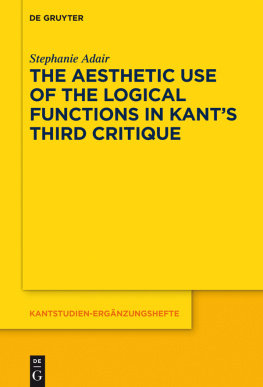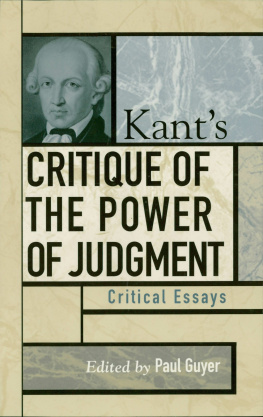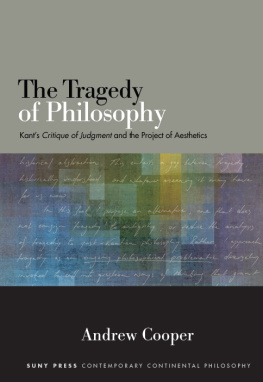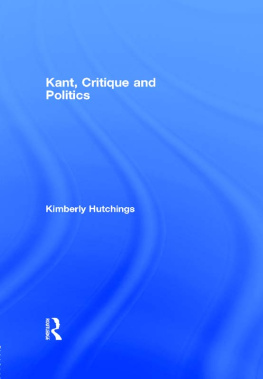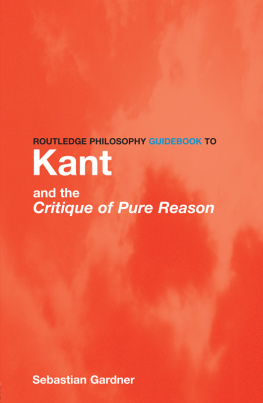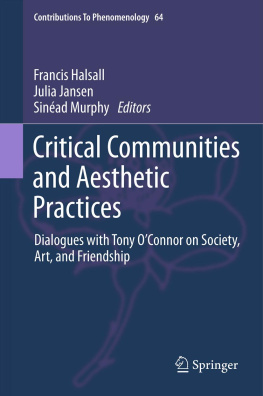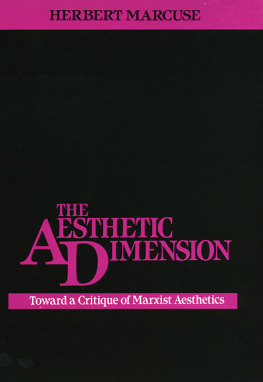Contents
Guide

Stephanie Adair
The Aesthetic Use of the Logical Functions in Kants Third Critique
Kantstudien-Ergnzungshefte

Im Auftrag der Kant-Gesellschaft
herausgegeben von
Manfred Baum, Bernd Drflinger
und Heiner F. Klemme
Band 202

ISBN 978-3-11-057479-1
e-ISBN (PDF) 978-3-11-057607-8
e-ISBN (EPUB) 978-3-11-057492-0
ISSN 0340-6059
Library of Congress Control Number: 2018946471
Bibliographic information published by the Deutsche Nationalbibliothek
The Deutsche Nationalbibliothek lists this publication in the Deutsche Nationalbibliografie; detailed bibliographic data are available in the Internet at http://dnb.dnb.de.
2018 Walter de Gruyter GmbH, Berlin/Boston
www.degruyter.com

To my mother and her love of Degas, Monet, Van Gogh and Renoir.
Acknowledgement
I would most especially like to thank Dr. Jennifer Bates for her close engagement with each chapter. The opportunity to respond to her careful comments and challenging counter arguments allowed me to gain not only crucial insights into the project, but also into the process of philosophical writing, itself. Dr. Dan Selcers feedback not only on the dissertation itself but also on the prospectus was instrumental in shaping this project. I also want to thank Dr. Claudia Bickmann for the opportunity to attend her seminars on Kant while writing the dissertation. They provided a constant source of stimulation and discussions with her were always fruitful.
List of Abbreviations
Major Texts by Kant.
Critique of the Power of Judgment
Critique of the Power of Judgment. Translated by P. Guyer and E. Matthews. Cambridge: Cambridge University Press, 2000.
Critique of Practical Reason
Critique of Practical Reason. Translated by Mary Gregor. Cambridge: Cambridge University Press, 2005.
Critique of Pure Reason
Critique of Pure Reason. Edited and translated by P. Guyer and A. Wood. Cambridge: Cambridge University Press, 1997.
Groundwork of the Metaphysics of Morals
Groundwork of the Metaphysics of Morals. Translated by H. J. Paton. New York: Harper & Row, 1964.
Jsche Logic
Jsche Logic. The Jsche Logic, Lectures on Logic. Translated by Michael Young, 521640.
Prolegomena to any Future Metaphysics
Prolegomena to any Future Metaphysics. Translated by Lewis White Beck. Indianapolis: Bobbs-Merrill, 1950.
Introduction
The cognitive judgments of the first Critique determine an intuition by subsuming it under a concept, but the aesthetic judgments of the third reflect upon an intuition without subsuming it under a concept. My project centers on the reflective judgment of taste. Thus, it is worthwhile to establish at the outset an understanding of what it means for a judgment to be reflective. Before laying out the central problem of my projectthe role of the logical functions in the merely reflective judgment of tastehere, I discuss how Batrice Longuenesse and Rudolf Makkreel read merely reflective judgment. Through this engagement with their readings, I develop my own conception of reflective judgment as akin to an Aristotelian praxis. I then give a brief overview of how the following six chapters work to decipher the aesthetic operation of the logical functions.
IReflective Aesthetic Judgment
Before presenting my project, let us look into what exactly Kant means by using the term reflective to describe the form of judgment with which he is concerned in the third Critique. Kant gives us his definition of the term: [t]o reflect (to consider), however, is to compare and to hold together given representations either with others or with ones faculty of cognition, in relation to a concept thereby made possible. Let us lay this definition of reflection alongside his description of how reflective aesthetic judgment operates to generate:
[that] sensation which the harmonious play of the two faculties of cognition in the power of judgment, imagination and understanding, produces in the subject insofar as in the given representation the faculty of the apprehension of the one and the faculty of the presentation of the other are reciprocally expeditious[].
The reflective activity of aesthetic judgment thus involves the comparison between the faculties of cognition. The imagination offers up an intuition, stimulating the understanding to seek a concept under which this intuition could be subsumed. A peculiarity of the merely reflective aesthetic judgment is that in holding together the faculties and comparing them, no concept is thereby made possible.
In Kant and the Capacity to Judge (1998), Batrice Longuenesse maintains that the truly novel contribution of the third Critique is the introduction of judgments that are merely reflective. Longuenesse suggests that every judgment includes an initial moment of reflection, during which an appropriate concept is sought for subsuming the particular intuition at hand.
Rudolf A. Makkreel offers a different reading of what makes aesthetic judgments reflective in Reflection, Reflective Judgment, and Aesthetic Exemplarity. Does this difference, however, mean that the two forms of judgment cannot both share in a reflective moment? I do not believe so.
Let me take the opportunity, here, to defend Longuenesses interpretation against Makkreels criticisms and show that understanding both determinative and merely reflective judgment as sharing a reflective moment does not reduce the former to an incomplete version of the latter, nor does it block merely reflective judgment from having further merely reflective characteristics, which are not developed by determinative judgment.
My first defense addresses Makkreels objection that the difference of the direction that each judgment takes when moving between particular and universal rules out the possibility that the course of these judgments may overlap in a moment of reflection. My second defense will address Makkreels allegation that conceiving of reflective judgment as a judgment which does not complete the last of the three acts of synthesis (recognition in a concept) would condemn it to be nothing more than an incomplete, and thus inferior, form of determinative judgment. While I agree that it would be incongruent with the status Kant accords to reflective aesthetic judgment if it were to amount to a mere precursor to determinative judgment, Longuenesses view does not necessitate such a reading. Instead, it makes greater sense to understand the paths of reflective and determinative judgment as converging for a certain segmentthis moment of convergence not being the final state for either form of judgment.
I do not dispute that Kant differentiates between reflective and determinative judgments in terms of the direction taken between particulars and universals. This can, however, be reconciled with the idea that the two forms of judgment share a reflective moment if we allow that the stages leading into and out of this moment differ. For reflective judgments, this search would naturally follow upon an intuition being reproduced by the imagination. For determinative judgments, however, the reflective moment would be something like a second beginning.

